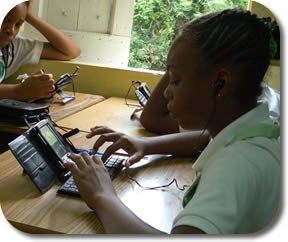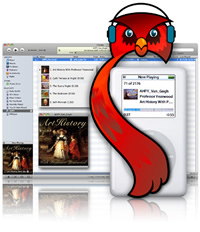Student Podcasting Questions & Suggestions
 Tuesday, November 6, 2007 at 5:00AM
Tuesday, November 6, 2007 at 5:00AM  Lyndon Domsten, Instructional Technology Specialist in Odessa, Texas, wrote to me, "I've actually written a grant with your Our City Podcast project as the center piece." That's a great idea! Our City makes for a great first podcast creation experience. Lyn is new to podcasting and has questions about it:
Lyndon Domsten, Instructional Technology Specialist in Odessa, Texas, wrote to me, "I've actually written a grant with your Our City Podcast project as the center piece." That's a great idea! Our City makes for a great first podcast creation experience. Lyn is new to podcasting and has questions about it:
We are very interested in participating in an Our City Podcast project. We (magnet class of 4th, 5th, 6th grade students) are learning how to podcast and are using Audacity for Windows for recording voice and integrating sound. You're probably thinking it's too bad I'm not using a Mac but our district uses only Windows machines.
GarageBand's advantage is that it is slightly easier to use than Audacity and that it has its own jingles, musical loops, and sound effects. Audacity on Windows is a fine program. You'll just have to seek out your own copyright-friendly music and sound effects that you can import into Audacity.
Nevertheless, we are needing guidance in creating our first podcast. On our website, I have been teaching kids how to make MP3 files to upload to our site. Can you tell me what RSS is exactly and how it fits into the process of podcasting?
Here's my definition of a podcast: A series of audio or video on the Web that can be cataloged and automatically downloaded. Putting MP3 files online could satisfy the first part of that definition. However, just linking to an MP3 file on your site will not allow users to automatically download the new files in a program like iTunes. In addition, MP3 files online cannot be catalogued in directories like iTunes, Podcast Pickle, and Educational Podcasting. Being listed in directories is how much of your audience will find your podcast. An RSS (a.k.a. Really Simple Syndication or Rich Site Summary) feed is necessary to be listed in those directories and essential for the MP3s to be automatically downloaded when new ones are posted.
A podcast has three parts: the MP3 file (or other media file), a webpage, and a feed. Posting just the first two online will probably reach much of your intended audience. While just a webpage linking to an MP3 file is not technically a podcast, I know many teachers who do call this podcasting. Just because it lacks an RSS feed doesn't mean that the activity lacks educational merit. However, we should strive to use proper vocabulary whenever we can.
We are going to work on an Our City script and record using Audacity. Can you offer any advice on that process.
I've recently written about the importance of listening to previous episodes before beginning the preproduction phase. Whether it's for Our City or for another podcast, analyzing example episodes (both good and not-so-good) help students make their own podcast better. Preproduction will take the most time--that's ok because it's the production phase where students are doing the most learning.
 I've tried student podcasting with scripts and without them. My advice: have students script everything they will say and have them practice, practice, practice. The recording process will go more quickly with fewer mistakes. When recording, I suggest using a headset USB microphone. Students tend to be fidgety when they record. Be sure that students don't touch the headset, mic, or cord. Providing a stress ball helps students put that energy in places other than cord-twisting and paper-shuffling.
I've tried student podcasting with scripts and without them. My advice: have students script everything they will say and have them practice, practice, practice. The recording process will go more quickly with fewer mistakes. When recording, I suggest using a headset USB microphone. Students tend to be fidgety when they record. Be sure that students don't touch the headset, mic, or cord. Providing a stress ball helps students put that energy in places other than cord-twisting and paper-shuffling.
I find it much easier to edit out mistakes as students are recording than to go back to fix them later. Audacity has a quirk that when you stop recording and resume, the new recording appears in a separate track. This does not happen when you pause recording. However, pausing doesn't allow you to edit the audio. I like to keep the audio tracks organized--one track per segment. So when a segment is broken into multiple tracks because I've stopped and started recording a few times, I Quick Mix the tracks into one. Do this by highlighting the tracks you wish to combine and then choose Project > Quick Mix. This will help your Audacity project be a little more organized and manageable.
Your first episode will take you a long time to edit as you get used to the tools. In the future, editing takes less and less time. Before you exported your edited audio to an MP3, I suggest exporting as a WAV file from Audacity. Then use The Levelator. It's free software Macintosh and Windows. You just drop that exported WAV file onto The Levelator's window and it will level out the sound. That means that loud voices will be toned down and soft voice will be made louder. This is important for a podcast when you have many different speakers--all of whom speak with different volumes. The Levelator will output a WAV file. You can important that into Audacity or iTunes and then export it as an MP3.
When we are finished with the final MP3 product, what is our next step....do we upload it to your site so you can post it? Do we send you pictures as well? The Our City Podcast we are creating isn't something I'm sure we will update on a regular basis but when we send it to you how does that affect the overall distribution of the file. Are we subscribing to an RSS feeder?
The beauty of Our City Podcast is that I take care of the posting. I host the MP3 file and I maintain the RSS feed. You just send me the MP3 file. I prefer to receive the MP3 files through the free service YouSentIt.com since it is a large file. In an email, send me up to five photos and a paragraph about the episode. See the pages for previous episodes so you can see what information is included. Also send any web links you want included on the page for your episode. Don't forget to include a catchy title that uses alliteration for your city. Again, see previous episode for examples like Outstanding Omaha and Lovely Lexington.
Our City episodes aren't meant to be updated. You contribute one episode and that's the end of your involvement. You can of course subscribe to the podcast so your receive new episodes as they are added.
Lastly, can you offer application ideas on how podcasting can be used on the elementary level?
Educational podcasting offers many possibilities! I think that an easy way to start your own podcast is with book reviews. Each episode could contain a review or two by students. Remember, a podcast is a series of episodes. If you plan just one episode, no one really needs to subscribe to it. Read my blog post Podcasting Notes about a presentation by Dan Schmidt. He's the author of Kidcast: Podcasting in the Classroom. I wrote about many of the innovative ideas for podcast formats and topics he shared in his video podcast.
Lyn, best of luck with podcasting! Once you get past the technical mumbo-jumbo you'll find that podcasting is really enjoyable and not as techie as it first sounds. It's more about communication than feeds, MP3s, microphones, and audio levels.
 podcasting
podcasting 





 GarageBand 3 (part of iLife '06 suite of software), Macintosh software for creating music and podcasts, allows for exporting as AAC but not MP3. Of course other programs like iTunes could be used to convert the AAC file to MP3. That extra step is an inconvenience for those who want to publish their podcast as an MP3.Apple's new GarageBand '08 (version 4 and part iLife '08), has some improvements for podcasters. One of them is the ability to export directly to MP3. By clicking Export Podcast to Disk... from GarageBand's Share menu, podcasters can choose to compress using either AAC Encoder or MP3 Encoder. If your podcast is not enhanced with the extra features of AAC, you might as well use the more compatible MP3 format.
GarageBand 3 (part of iLife '06 suite of software), Macintosh software for creating music and podcasts, allows for exporting as AAC but not MP3. Of course other programs like iTunes could be used to convert the AAC file to MP3. That extra step is an inconvenience for those who want to publish their podcast as an MP3.Apple's new GarageBand '08 (version 4 and part iLife '08), has some improvements for podcasters. One of them is the ability to export directly to MP3. By clicking Export Podcast to Disk... from GarageBand's Share menu, podcasters can choose to compress using either AAC Encoder or MP3 Encoder. If your podcast is not enhanced with the extra features of AAC, you might as well use the more compatible MP3 format.

 GarageBand's presets make a really handy reference. In fact, podcasters using Audacity and other recording programs could use these same settings when encoding audio. You'll have to manually input the settings after choosing Preferences > File Formats. Under MP3 Export Setup, change the Bit Rate to match GarageBand's preset. For example, set the Bit Rate to 64 for a Spoken podcast.
GarageBand's presets make a really handy reference. In fact, podcasters using Audacity and other recording programs could use these same settings when encoding audio. You'll have to manually input the settings after choosing Preferences > File Formats. Under MP3 Export Setup, change the Bit Rate to match GarageBand's preset. For example, set the Bit Rate to 64 for a Spoken podcast. Audacity
Audacity

 It's time for some podcasting tidbits.
It's time for some podcasting tidbits. Soundsnap
Soundsnap
 The most technical part of
The most technical part of  The second edition of Handhelds for Teachers & Administrators by Tony Vincent and Janet Caughlin is now available! You might be familiar with the first edition published four years ago. Edition 2 has been completely updated and has an added 50 pages. Besides taking you step-by-step through using Palm handhelds, Pocket PCs, iPods, and podcasting, the book gives dozens of examples of classroom use. In fact, the vignettes with teacher lesson idea and their insights into handheld computing is my favorite chapter. There's also a chapter with school administrators telling you all about how they use handhelds to do their jobs better.
The second edition of Handhelds for Teachers & Administrators by Tony Vincent and Janet Caughlin is now available! You might be familiar with the first edition published four years ago. Edition 2 has been completely updated and has an added 50 pages. Besides taking you step-by-step through using Palm handhelds, Pocket PCs, iPods, and podcasting, the book gives dozens of examples of classroom use. In fact, the vignettes with teacher lesson idea and their insights into handheld computing is my favorite chapter. There's also a chapter with school administrators telling you all about how they use handhelds to do their jobs better.
